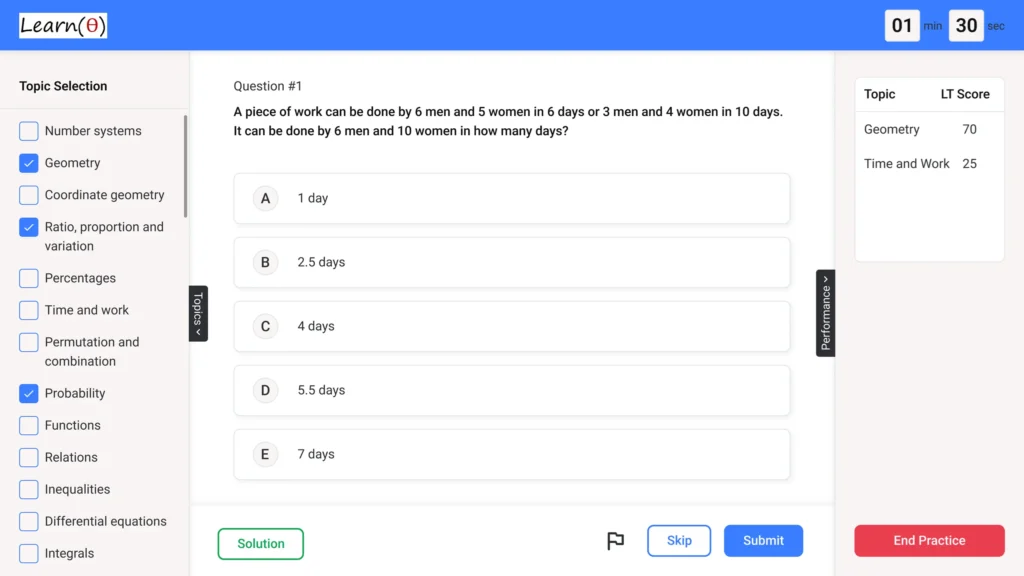Cadence – Aptitude Questions & Answers for Placement Tests
Reviewing Previous Year Questions is a good start. Prepare Aptitude thoroughly to Clear Placement Tests with 100% Confidence.
Q.1 A number z when divided by 120 leaves 25 as a remainder. The same number when divided by 15 leaves w as a remainder. The value of w is
Check Solution
Ans: C
We know that z = 120k + 25, for some integer k. We can rewrite 120 as 15*8. Therefore, z = (15*8)k + 25. Now, 25 divided by 15 leaves a remainder of 10. So, (15*8)k will leave a remainder 0 when divided by 15. Hence the total remainder is 0 + 10 = 10.
Q.2 An equation of the form ax + by + c = 0 where a = 0, b ≠ 0, c ≠ 0 represents a straight line which is
Check Solution
Ans: A
When a = 0, the equation becomes by + c = 0, or y = -c/b. Since -c/b is a constant, this represents a horizontal line parallel to the x-axis.
Q.3 The sum of the digits of a two-digit number is 9. If the digits are reversed, the new number is 9 more than the original number. Find the original number.
Check Solution
Ans: B
Let the tens digit be x and the units digit be y. Then x + y = 9 and 10y + x = 10x + y + 9. Simplifying the second equation gives 9y – 9x = 9, or y – x = 1. Solving the system of equations x + y = 9 and y – x = 1 gives x = 4 and y = 5. So the original number is 45.
Q.4 Determine the probability that a card drawn at random from a standard deck of 52 playing cards will be a face card (Jack, Queen, or King).
Check Solution
Ans: B
There are 12 face cards (4 Jacks, 4 Queens, and 4 Kings) in a deck of 52 cards. The probability is the number of face cards divided by the total number of cards: 12/52 = 3/13
Q.5 What is the probability that a die will show a 6 at least once in four rolls of the die?
Check Solution
Ans: B
The probability of NOT getting a 6 on a single roll is 5/6. The probability of NOT getting a 6 in four rolls is (5/6)^4 = 625/1296. Therefore, the probability of getting a 6 at least once in four rolls is 1 – 625/1296 = 671/1296.
Q.6 The simple interest on Rs. 6000 at y% per annum for 4 years is the same as the simple interest on Rs. 8000 at 10% per annum for 3 years. What is the value of y?
Check Solution
Ans: A
SI = (P * R * T) / 100. For the first case, SI = (6000 * y * 4) / 100 = 240y. For the second case, SI = (8000 * 10 * 3) / 100 = 2400. Equating, 240y = 2400, so y = 10.
Q.7 If a + 1/a = 4, then the value of a3 + 1/a3 is:
Check Solution
Ans: A
Cube both sides of a + 1/a = 4: (a + 1/a)^3 = 4^3. Expanding gives a3 + 3a + 3/a + 1/a3 = 64. Rearranging, a3 + 1/a3 + 3(a + 1/a) = 64. Substituting a + 1/a = 4 gives a3 + 1/a3 + 3(4) = 64, so a3 + 1/a3 = 64 – 12 = 52.
Q.8 After offering a discount of 20% on the marked price of a shirt, a shopkeeper still makes a profit of 12%. If the cost price of the shirt is Rs. 880, what would be the profit percentage if the shirt was sold at the marked price?
Check Solution
Ans: D
Let the marked price be M. Selling price = 0.8M. Profit = Selling Price – Cost Price. Profit percentage = (Profit/Cost Price) * 100 = 12%. Selling Price = 880 + (12/100)*880 = 880 + 105.6 = 985.6. So, 0.8M = 985.6; M = 985.6/0.8 = 1232. Profit at marked price = 1232-880=352. Profit percentage = (352/880)*100 = 40%.
Q.9 The sum of six numbers is 480. The average of the first three numbers is 45 and the average of the last two numbers is 85. What is the fourth number?
Check Solution
Ans: D
Sum of first three numbers = 45 * 3 = 135. Sum of last two numbers = 85 * 2 = 170. Therefore, fourth number = 480 – 135 – 170 = 175. However, we can’t determine the fourth number with the given info.
Q.10 A shopkeeper initially had 40 apples and 60 oranges. He sold an equal number of apples and oranges. If the ratio of apples to oranges remaining is 2:3, how many fruits did he sell in total?
Check Solution
Ans: C
Let x be the number of apples and oranges sold. Remaining apples: 40 – x Remaining oranges: 60 – x (40 – x) / (60 – x) = 2/3 3(40 – x) = 2(60 – x) 120 – 3x = 120 – 2x x = 0. Therefore the number of fruits sold is not applicable. But that will not be an option. The ratio is probably meant to be 1:3 Then (40 – x) / (60 – x) = 1/3 3(40 – x) = 60 – x 120 – 3x = 60 – x 60 = 2x x = 30 Total fruits sold = 30 + 30 = 60. That option is not there. Assuming the question wants to find the number of apples and oranges that remain after selling, then (40 – x)/(60 -x) = 2/3 3(40-x) = 2(60-x) 120-3x = 120-2x 3x-2x = 120-120 x=0 The fruits sold are 0 each then, the total fruits sold would be 0 Considering an alternate ratio 1:2 (40-x)/(60-x) = 1/2 80-2x = 60 -x x = 20. 20 each are sold, which totals 40
Next: Cairn Aptitude Questions
Refer Company wise Aptitude Questions
Practice 1000s of Aptitude Questions with Answers for Quant, Reasoning & Verbal
Fastest Way to Crack Aptitude Tests – LearnTheta’s AI-Practice!

✅ All Topics at One Place

🤖 Adaptive Question Practice

📊 Progress and Insights